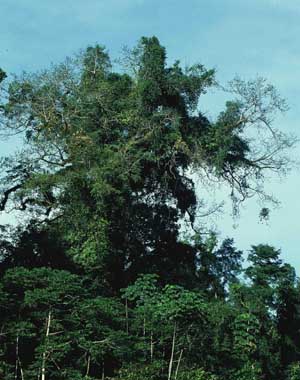|
|
 65 epiphytes DHJanzen100376.jpg high resolution
|
|
| In tropical forests, a substantial part of what looks like the green forest canopy is actually not tree foliage. In some places, vine crowns are a major part of the non-tree foliage. But epiphytes can also be a major part. Epiphytes are plants that grow on other plants (they are not parasites in the sense of drawing their nutrients directly from the plant underneath, though epiphytes can be viewed as a kind of structural parasite owing to their weight and maintaining a soil/swamp layer on horizontal branches). In this image, a large Ceiba pentandra tree in Costa Rican rainforest has dropped its entire leaf crop for a month in the short dry season. Those are the leafless branches poking out around the margin of the crown. ALL the rest of the green foliage in this tree crown belongs to epiphytes. Being an epiphyte is a way of getting your crown up into the canopy without spending all the resources (and strategic moves) that it takes to grow and maintain either a massive self-supporting trunk or being a vine. Being an epiphyte pays the price, however, of having to depend on, instead of the litter and soil, the air for the incoming mineral nutrients. And when the rains stop, that tree canopy dries down to desert status very rapidly (which is part of why the tropical rain forest cacti are epiphytes). | ||
back to lecture slides
or skip to: